The agricultural journalists on this week’s media event in Germany had the honor of being able to personally interview some of the top corporate executives of BASF Agricultural Products.
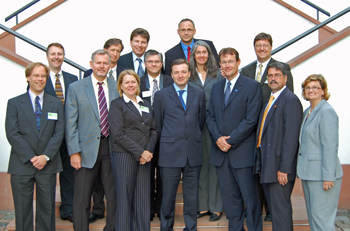 You have to admit, this is a darn good looking group. We do clean up well. Along with myself, the seven other journalists on the trip and our BASF communications manager hosts are pictured BASF Ag Products division president Michael Heinz, with group VP for strategic marketing of ag products Emmanual Butstraen to his left and group VP North America Ag Products Markus Heldt to his left. Top middle is Peter Eckes, Senior VP for Global R&D. I already posted an interview with Michael and will feature interviews with the others here in future posts.
You have to admit, this is a darn good looking group. We do clean up well. Along with myself, the seven other journalists on the trip and our BASF communications manager hosts are pictured BASF Ag Products division president Michael Heinz, with group VP for strategic marketing of ag products Emmanual Butstraen to his left and group VP North America Ag Products Markus Heldt to his left. Top middle is Peter Eckes, Senior VP for Global R&D. I already posted an interview with Michael and will feature interviews with the others here in future posts.
I will identify everyone else later. It’s late here in Brussels where we arrived this evening. We had a nice dinner on the town and have an early day Friday with EU ag officials, which should be very interesting. Stay tuned for more and check out the latest photos for our last day in Germany at the BASF research facility where we learned about prescreening of compounds, fungicide research, ecotoxicology, and seed treatment. I promise much more later.
POST UPDATE: Here are the names of the rest of the folks in the picture, in no particular order: Wayne Wenzel, Farm Journal/Top Producer; Don Green, Ag Day TV/US Farm Report TV; Willie Vogt, Farm Progress; Eric Sfiligoj, CropLife; Gil Gullickson, Successful Farming; Greg Lamp, Corn and Soybean Digest; Greg Horstmeier, DTN/Progressive Farmer; Pat Morrow, BASF Communications Manager, Elise Kissling BASF Global Communications Manager. Dan Muys with Quarry Communications gets the photo credit – and a lot of other credit too. He, Pat and Elise, as well as Elise’s assistant Michele, just did an incredible job setting up this trip and taking care of us.

 That title comes straight from
That title comes straight from 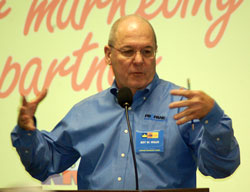
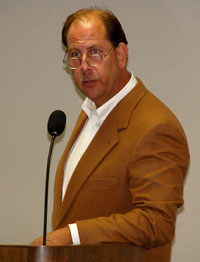
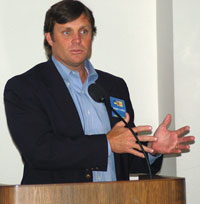 Some of the latest propane technology pairs propane with solar power to offer hybrid electricity generation systems. Stuart Weidie, Chairman of the
Some of the latest propane technology pairs propane with solar power to offer hybrid electricity generation systems. Stuart Weidie, Chairman of the 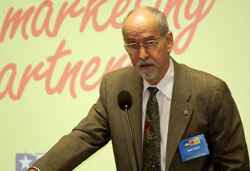
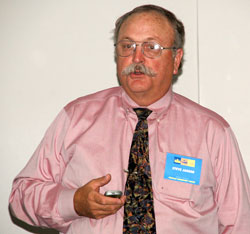 He said the pick-up burned to the ground while there was no escape of gas from the bus. He added that all the children riding the bus exited safely without any instance of injury or death. Dan said industry leaders joke about the safest place to put a propane gas tank in a motor vehicle: “make it the bumper.” He said 12,000 vehicles run on propane fuel in Texas.
He said the pick-up burned to the ground while there was no escape of gas from the bus. He added that all the children riding the bus exited safely without any instance of injury or death. Dan said industry leaders joke about the safest place to put a propane gas tank in a motor vehicle: “make it the bumper.” He said 12,000 vehicles run on propane fuel in Texas.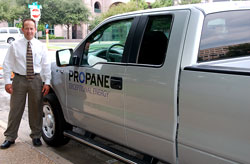 Chuck has already
Chuck has already  Paul Funk is one of the experts at the 2007 Propane Technology Forum who has taken all the talk about innovative propane research a step further. Paul is a scientist with the USDA-Southwestern Cotton Ginning Research Laboratory. He is among the first to put heat defoliation of cotton with propane into practice. Paul and I discussed what he’s encountered out in the field.
Paul Funk is one of the experts at the 2007 Propane Technology Forum who has taken all the talk about innovative propane research a step further. Paul is a scientist with the USDA-Southwestern Cotton Ginning Research Laboratory. He is among the first to put heat defoliation of cotton with propane into practice. Paul and I discussed what he’s encountered out in the field. Paul Funk’s heat defoliation of cotton isn’t the only way propane-generated heat is being used. Temp-Air scientist Raj Hulasare says propane heat remediation is an ideal solution for treating bins, silos, and other storage vessels for pests. He adds that propane heat remediation is a particularly viable option for certified organic farms, which are restricted from using many chemicals to treat their stored crops.
Paul Funk’s heat defoliation of cotton isn’t the only way propane-generated heat is being used. Temp-Air scientist Raj Hulasare says propane heat remediation is an ideal solution for treating bins, silos, and other storage vessels for pests. He adds that propane heat remediation is a particularly viable option for certified organic farms, which are restricted from using many chemicals to treat their stored crops. Several experts in the propane industry mentioned the innovative use of propane as an insecticide at the 2007 Propane Technology Forum, but Robert McGee with Texas A&M Agriculture Research is the expert whose presentation focused solely on propane’s capability to eliminate pests. In a brief interview, Robert and I reviewed the main idea of his presentation.
Several experts in the propane industry mentioned the innovative use of propane as an insecticide at the 2007 Propane Technology Forum, but Robert McGee with Texas A&M Agriculture Research is the expert whose presentation focused solely on propane’s capability to eliminate pests. In a brief interview, Robert and I reviewed the main idea of his presentation.